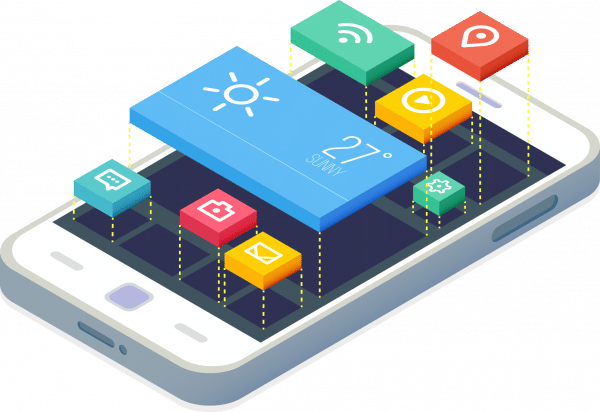App Features & Complexity
To estimate how much money the app will cost to develop, you need to understand the full extent of the features you are going to be adding to the app. Both the quantity and complexity of features will impact the development hours and the app type you will end up with.
Moreover, the complex features take longer to be developed compared to basic or common features, increasing the overall development costs. For this purpose, you can use the following formula to calculate the app cost:
Features X development time per feature X hourly rate = app cost
When you are curating the list of features, it’s better to consider the long-term business objectives and choose the ones that are of interest to your audience. In some cases, the developers might have to add pre-designed templates and/or third-party APIs that add extra up-front cost but reduce development time.

Also, the creation and maintenance of complicated features has a more expensive price tag compared to basic features. When considering which features to include, you will want to give each feature a priority ranking or score. That way, you can determine which features you might be able to delay adding until later releases, depending on how much money you are looking to spend at the outset.
Some of the basic features for different types of apps include:
As we’ve mentioned, the complexity of the app also impacts the cost. More complex features can include:
If you have a limited budget and cannot manage high costs or price tags, you could prioritize the features that fit the budget range and add or improve features later according to the users’ feedback.
In addition, during the development project, there might be some unforeseen changes, which is why it’s best to choose the essential features and improvise accordingly.
Start With An MVP
In particular, if you are looking to build a brand-new product that does not have an existing userbase, it’s advisable to begin with an MVP. MVP stands for “minimum viable product”, that is, a bare-bones version of the product that includes only the features that are absolutely necessary to deliver your solution.
An MVP allows you to achieve proof of concept, showing that there is a customer base out there looking for your product. Significant proof of your concept can help you raise capital, find business partners, and craft a more formal product that can be brought to the market at large. It can also help you understand the best way to monetize your app.
Start With One Platform
In addition to features, it is important to consider the best platform to start with as well. Sure, it would be great to launch your beta with a web app and native mobile apps for both Android and iOS. The reality is, however, that this adds significant extra cost at the outset of the project.
If your project is mobile-first, then the best approach is to use a cross-platform development option or, if native capabilities are important, select one platform to develop on first.
The choice of mobile platform can have a variety of factors. For example, if your target market is the United States, you may want to start with iOS, but if you’re targeting international users, Android is far more common.
As a result, it is also easier to find Android developers and thus your mobile app development cost will likely be lower for a native Android app than a native iOS app.
Development Partner
Deciding who will build your app is an important consideration, irrespective of whether you will hire a development agency or hire freelance development. In addition, if you have an existing business or capital to work with, you have the choice of hiring a professional for an in-house development team.
All of these approaches have pros and cons, but it’s important to select the right development partner because it also influences the development timeline. Let’s look at the differences because they directly impact how much money it will cost to build an app.
Freelancers
This is the most cost-effective way of building an app as long as the app is not too complicated. If you manage to find a talented freelancer, they will build a high-quality app at much less cost as compared to getting the app developed by an agency. However, the final costs depend on the location of freelancers since the hourly rate is around $50 in the U.S. while it starts from $10 in India, making a huge difference in average cost.
Be careful about chasing “low cost”, however, particularly when outsourcing to other countries. We will discuss some of the risks of doing so further below.

Also, keep in mind that one freelancer may not be able to handle everything, so you will likely want to hire a different freelancer for quality assurance, design, coding, and other tasks, so don’t be misled by a cheaper initial price.
Another risk to consider when going the freelancer route is that you may not have access to the same developer long term. Once your initial project is complete, the freelancer will likely move on to another project, meaning they may not be available for bug fixes, revisions, new features, etc.
On top of the aforementioned concern, if you do end up having to switch to another freelancer due to availability issues, you will need to bring the new developer up to speed on the project. This transition can be smooth, but the likelihood is that there will be more than a few bumps in the road.
Risks Of Offshoring Development
It’s easy to get sticker shock when comparing development in countries like the U.S. when compared to a country like India, but there are significant risks that come with the lower price tag.
First and foremost, speaking from extensive experience here at Backendless, we have encountered many projects that were built using a low-cost overseas freelancer, and the results are almost universally the same. Time and again, the project that is delivered is so poorly developed that the entire project needs to be rebuilt from scratch.
Inexpensive developers have an incentive not to create the best product, but to create as many “acceptable” products as possible, as quickly as possible. When a developer cuts corners to save time and cost, the result is often unsalvageable code, poor performance, and subpar (or worse) visual design. In the end, the client is left paying for an entirely new app to built, scrapping whatever end result they received from the freelancer and eating the cost.
Even if the final product is acceptable as an MVP or proof of concept, it does not serve as any form of foundation for future development. New features, improved UI, performance upgrades, etc., inevitably must all be done from scratch, leaving the initial development as a purely sunk cost.
Freelancing Summary
To summarize, there is not one perfect app developer, which means you may need to hire multiple freelancers to handle different aspects of the app, leading to a slightly higher price tag. You may also be forced to change developers midway through the project, presenting added risk. And if you choose the lowest-cost freelancer option, you often end up paying as much or more for your project in the end.
We recommend using the freelancer route only for an MVP or early prototype, and finding a more long-term solution once you’re ready to build your final product.
Agency
Hiring an app development company or agency is more beneficial, convenient, and reliable. It is more expensive, but it promises quick and effective results as they have a team of app developers with experience of creating different web and mobile apps. This is because the teams have more discipline and involvement in the process without compromising on communication.

The app development company promises on-time project completion while delivering promised results that provide value for your money. This is because they have a full infrastructure, resources, and app developers with extensive experience in app development to deploy the apps after development while the team of professionals can guide them through the app planning and development phase.
When hiring a mobile app development company, be sure to vet their experience with all mobile platforms. If you need both an iOS and Android app, you don’t want to hire a mobile app development company that specializes only in one or the other.
Additionally, before hiring an app development team, be sure you discuss ongoing app maintenance costs. A typical engagement may include 6-months to a year of support for the app, to ensure that all initial bugs and errors are uncovered and resolved.
Lastly, don’t forget to pay attention to hidden application development costs, such as hosting and product licensing. You want to be sure that the product that gets built belongs to you, not the agency, and that you can take it to another agency, freelancer, or bring development in-house when the time comes.
DIY Method
For many types of apps, there are many tools available for building apps and supporting the app development project that have a no-code configuration, so you can build the app on your own. These app builder tools allow you to create the app on your own at a much more affordable price and offer more control since there are no upfront costs of app development.
Read all about no-code vs low-code vs full code development here.

If you have time to dedicate to learning a platform before starting to build, this can be a great way to go. Even if you prefer not to do the development yourself, no-code agencies can be a great way to build quickly and often are far less expensive than traditional agencies. Backendless has partnered with several no-code agencies for this very reason.
Note, however, that for some platforms, out of the box features may be limited, meaning you will need to spend a lot of time exploring your options before you select a platform. Additionally, some platforms have more flexibility in what you can do on your own accord than others. Luckily, we’ve curated a list of the top no-code app builders to help you do your research.
When choosing a no-code platform, you need to be aware of scaling challenges as well. Unlike Backendless, many are great for early-stage growth and MVP usage, but struggle mightily when your userbase and database grow.
The Bottom Line
Considering how much apps cost to develop can be an overwhelming experience when there are a plethora of options to consider. With this article, we covered all the potential factors that can impact the costs, how they impact the project timeline, and the prime concept of project management triangle.
Some takeaways include:
- Mobile projects and web projects have different costs, advantages, and drawbacks
- Different types of apps can have a significantly different app cost
- Understand the complexity of the app development project before you start shopping
- Realize that the app development process timeline is longer than you expect
- A lot of factors go into the final price tag
To summarize, the development of an app of good quality ranges from a few thousand dollars all the way up to $300,000 or more. So, take a day out to weigh your options and make an informed choice for your app development project. Not to forget, keep a flexible and appropriate mobile app development budget!





